How to Make Persuasive Writing as Fierce as Wolverine
Regardless of whether you are a sales or a business person, students or other professional, in many cases in written communication, you need to make an impact on the reader and persuade, in order to advance our goals. The following principals are all it takes to persuade through writing.

Get Ready to Rumble
Like on a trip, so do persuasion. Before we set out, we must prepare ourselves for it. Therefore, when we set out, we must pay attention to the following three points:
A. To whom we are talking to - we must write as if we are talking to one person who represents our audience. Therefore, we must focus as accurately as possible on the definition of the audience we are talking to. The more we focus, the more personalized the message becomes, and will enable us to touch points that are important to our audience.
B. What they are focusing on right now - we need to understand "where they are" in their minds right now. Therefore, we must ask ourselves questions such as: What is their opinion on the subject? What bothers them most at the moment? What makes them not trust people? What did they do just before they were exposed to the persuasive message?
C. What they will have to do in the end - this question deals with the focused purpose for who we write the message. Do we want to give them a point of thought? Do we want them to do something? Will it be now or later? What steps should they take to reach the final result?
Once we have defined these three points, we have created a kind of route, and we take the audience from where they are, where we want them to go, and in the next stage we want to make the message much more efficient.
The following guide lines are intended to help our message to effect and persuade others.
-
Identification as a source of authority
If we prove to people that we understand their problem, they will also believe that we have the solution to this problem. Therefore, we must describe their aspirations and the reasons why they have not yet reached them. -
Start, middle and end
A simple message bores people. When the message has a beginning, middle and end it gives a narrative feeling, even if it's not a story. Example of a good structure: What I dreamed of achieving > what really happened to me > how I found a solution > Why I decided to share the solution> how this solution can be yours. -
Reasonable Persuasion
It is important to know how to make sense. In order to create a logical message, we build it from a number of arguments (main message) and arguments (proofs and explanations of the message). At every stage of the message we claim an argument and immediately follow it with proofs that support it. -
Stories and analogies
Stories suspend critical thinking, drag us to imagine and subconsciously implant the moral, as long as we do not tell it. -
Factual speech
Since it is easy to contradict what a person says, we must learn to use factual speech. The previous sentence, for example, does not say who said it and is formulated as fact. It has a judicial determination and a structure of cause and effect that helps it to sound factual. -
A simple main message
A catchy message that can be summarized in a short sentence or phrase. Therefore, if we want the audience to tell others about the message, we need to build it so that it will be easy for others to tell it. For example: Apple is "innovative", 'Game of thorns' is "breathtaking" and etc. -
Repeat and repeat
Following the previous point, we must repeat our message at least 3 times. At first, middle and end. It adds a dramatic touch and helps us connect the arguments to the central idea. Especially if it is formulated in a simple way. -
Grouping
Everyone wants to know how the message is connected to them. Therefore, we have to create a group in advance that he wants to belong to that makes him feel positive. On the other hand, we must create a group that he does not want to be part of. For example: a real man uses a male deodorant, [a brand name]. -
Using Facts
Although persuasion is ultimately done on impulse, people like a good explanation. The use of demonstrations, proofs, facts, studies, and statistics makes the message sound much more persuasive. However, it should be noted that in most cases backing claims with facts will only work if they make sense.



